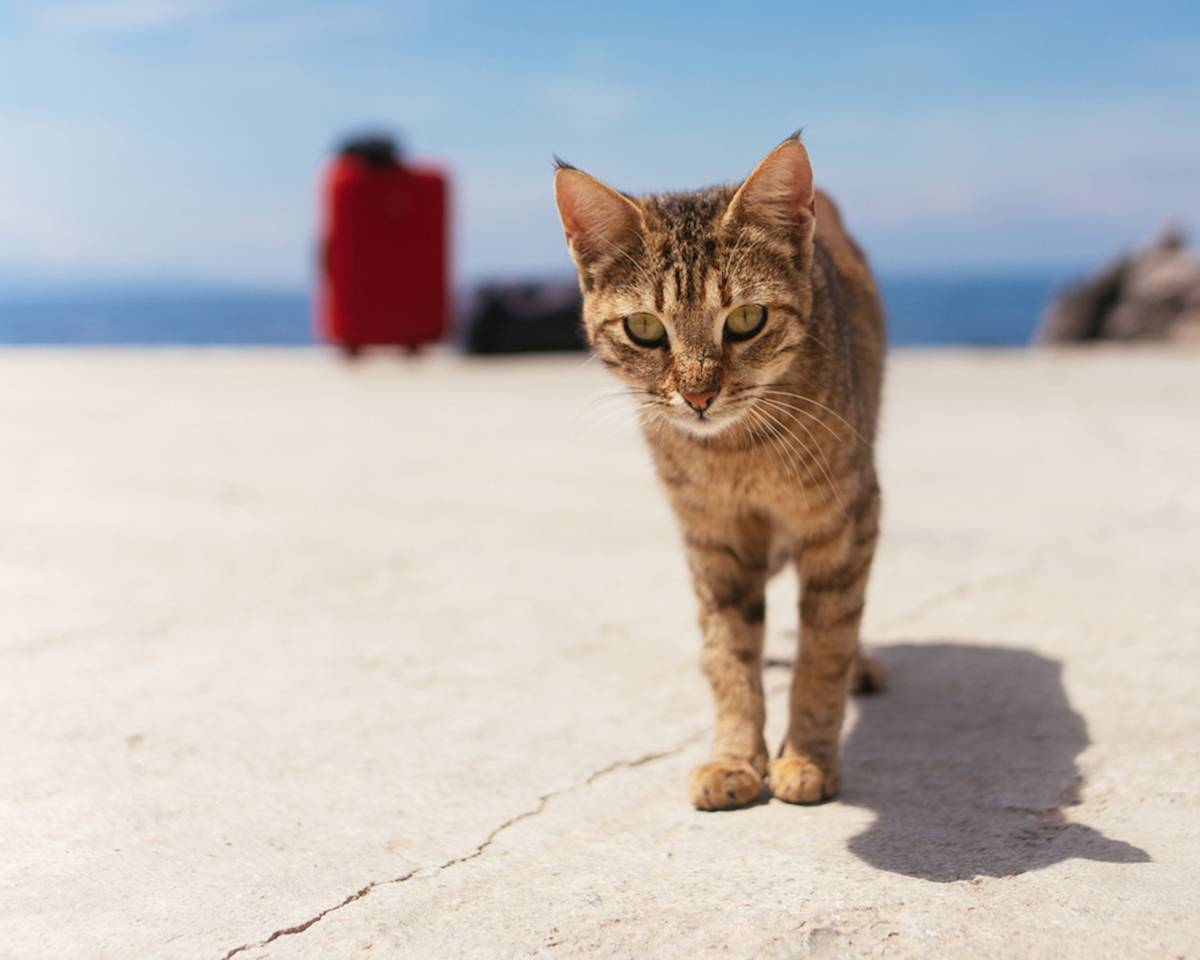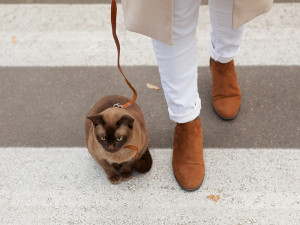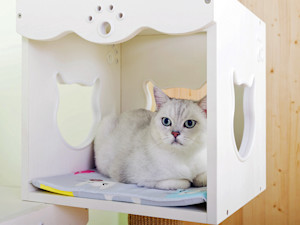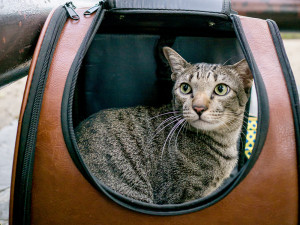Instagram vs Reality: Should You Really Take Your Cat on Holiday?
Vets reveal why most cats hate travel

Share Article
Summer holiday season is here, and as devoted cat parents, the thought of leaving our beloved felines behind can feel heartbreaking. We want to create memorable moments with our furry companions, sipping meow-jitos together and sharing adventures.
Instagram feeds are filled with jet-setting cats who’ve racked up millions of followers travelling the world with their humans, and taking cats on holiday seems to be a trending topic on TikTokopens in new tab. But while these feline influencers may look perfectly content posing in exotic locations, is dragging cats on holiday actually in their best interests? We put the question to the experts.
Behind the Instagram filter: the hidden reality
Those picture-perfect travel posts don’t tell the whole story – cute photos can easily mask stress and discomfort. Many influencer cats are specially trained animals with unique personalities, and experts warn against assuming your average house cat would enjoy the same nomadic lifestyle.
“The cats we tend to see on social media have likely been eased into this lifestyle and naturally have a more outgoing personality,” explains Samantha Prior, DipCABT C.C.A.B, Cat Advisor at Woodgreen Pets Charityopens in new tab. “As we don’t see the full story on social media, we don’t know if there are cases where these cats haven’t been as happy about travelling.”
Veterinary surgeon Francesca Verney, BA VetMB MRCVS, urges cat parents to be realistic about their pet’s preferences: “Think carefully about your cat’s breed, personality and what they really like. Not what you think they like. Cats who enjoy moving around and travelling are in the massive minority, so start from the point of assuming your cat would rather be curled up in the sun in their own home.”
Territory and routine: understanding your cat’s true nature
Cats are fundamentally creatures of habit who thrive in familiar, safe environments. Their strong attachment to territory makes travel inherently stressful for most, and routine and predictability are absolutely key to a cat’s well-being.
“Cats like routine, so taking them away from the safety of their home comforts and familiar smells can be too much, causing them to be unhappy and stressed,” says Prior. “Most cats would prefer to stay in their own environment. Cats love to explore but also love routine, so having this in their own home and outdoor space is best. This way they’re surrounded by familiar scented items and home comforts. If they do get scared, they can run right back to their safe space.”
Cats Protection vet Sarah Elliott reinforces this point: “Most cats find travelling stressful. They feel safe in a familiar environment and are not used to the different smells, noises and sensations of travelling in a vehicle.”
Verney describes cats as “creatures with territories, rhythms, priorities in opposition to holidaying humans who generally prefer to stick to their ‘eat, prey, love’ at home.”
The exceptional few: which cats might actually enjoy travel?
While the overwhelming majority of cats prefer staying home, there are some exceptions. Certain breeds such as Ragdolls, Maine Coons, Siberians and Burmese, along with younger cats, might adapt better to travel, according to Verney. Outgoing personalities and early training are crucial factors in determining whether a cat might cope with adventures.
However, experts stress that this represents a tiny minority of the feline population. Verney estimates that just five percent of cats actually benefit from or enjoy travel compared to being left at home – a sobering statistic for hopeful cat parents dreaming of shared adventures.
Reading the signs: happy traveller or stressed passenger?
Understanding whether your cat is genuinely enjoying travel or simply enduring it requires careful observation of their body language and behaviour. The differences between contentment and stress are often subtle but crucial.
“Key signs a cat is enjoying an experience include a relaxed posture and walking around confidently, not cowering away or sticking to covered areas,” explains Prior. “Their tails will be high, ears forwards, eyes relaxed and not dilated. They will also appear relaxed and calm in their interactions with you.”
Verney adds that “A happy cat should be seeking touch and affection, not hiding and able to eat in the setting.”
Warning signs of stress are equally important to recognise. “Stress signs might include anxious facial expression, stress purring, vocalisation, pacing, passing wee or poo, or hiding and not wanting to interact,” warns Verney. If your cat isn’t clearly relaxed, it’s likely not a good fit for travel.
The cautious approach: introducing travel gradually
For those determined to attempt travel with their cats, experts recommend an extremely gradual approach – and being prepared to abandon the plan if stress signs appear.
“As a charity, we would advise against trying to introduce any cat to travelling in this way,” states Prior. “However, if people are going to try it, the best approach is with slow introductions to wearing a harness and going outside, using positive rewards such as high value treats to get them used to it.”
Verney suggests a methodical progression: “See if they are happy to be harness trained in the home and start with garden time like this then increasing areas of stimulation such as local parks and cafes. Take it slow, read your cat’s signs and assume, based on percentage likelihood, that your cat is not going to suit the nomadic lifestyle.”
Common mistakes that spell disaster
Even well-intentioned cat parents can make critical errors when attempting to travel with their pets. The most common mistakes involve ignoring obvious stress signals and failing to prepare cats properly before the trip.
“Assuming their cat loves to travel and not observing their body language, as well as not getting their pet used to wearing a harness outside in advance,” are typical errors, according to Prior.
Verney identifies another crucial mistake: “Not recognising the cat’s stress and pressing on regardless, wrongly thinking that the cat being with its owners is better than anything else.”
The consequences can be severe. “For cats who are travelling but don’t enjoy it, this could cause them severe fear, changing their character towards both their human and the home environment,” warns Prior. “It may also result in behavioural issues as cats never feel they have a safe space to relax and are constantly on alert.”
The expert verdict: when travel makes sense
The professional consensus is clear: experts advise against travelling with cats unless absolutely necessary, such as for vet visits or house moves. The approach must be individualised, with the cat’s comfort and mental health taking priority over the pet parent’s desires.
“It’s best to only take your cat on trips if absolutely necessary, like going to the vet or moving to a new place,” advises Elliott from Cats Protection. “We’d encourage pet parents to take steps to make these shorter journeys as stress-free as possibleopens in new tab. If your cat gets very stressed when travelling, speak to your vet as they can discuss further options.”
Verney emphasises the importance of individual assessment: “No blanket rule applies and the worst thing we can do is close off the discussion. As vets we would rather discuss the individual cat, human and environment and work out what might be suitable.”
Prior sums up the fundamental principle: “Every cat is an individual and has their own unique personality. It’s important that all cat owners watch their cat’s body language and listen to what they are communicating with us – this is the only way we can truly see what is best for our cats.”
Guilt-free alternatives: keeping cats happy at home
While it’s natural to feel guilty about leaving our cats behind whilst we travel, it’s generally in their best interests to stay in familiar surroundings. There are numerous ways to ensure your cat remains comfortable and entertained while you’re away.
Enlist trusted pet sitters, friends or reputable catteries to provide care and companionship. Enrich your cat’s home environment with new toys, puzzle feeders and familiar scent items to keep them engaged. Modern technology offers additional peace of mind through video calls, automated feeders and home cameras that allow you to check in on your furry friend.
Read your cat, not your social media feed
While a select few cats may genuinely enjoy travel adventures, the vast majority would rather remain curled up in the sunshine at home – not at the beach. The key is learning to read your cat’s genuine preferences rather than projecting your own travel desires onto them.
The best holiday decision for your cat is ultimately the one that keeps them happy, safe and stress-free – even if it means leaving them behind whilst you explore the world. Your Instagram feed might be less exotic, but your cat’s well-being will thank you for it.
The bottom line: should you take your cat on holiday?
While the idea of taking your cat on holiday may seem appealing – and looks great on social media – the reality is that most cats are happiest at home in their familiar territory. Travelling can be deeply stressful for them, and unless your cat is one of the rare few who genuinely enjoys it, the best way to show your love is to provide calm, secure care while you’re away.

Natalie Gil
Natalie Gil is a freelance journalist who has written for iNews, the Irish Independent, Stylist and more. She previously worked at Refinery29, Monzo and the Guardian, and is the proud cat mum of British Shorthairs Prune and Oat.
Related articles
![A Burma breed cat on a leashed harness sitting near a feet of a girl at a pedestrian crossing.]()
How to Walk Your Cat On a Lead
Adventure Cats author Laura Moss’s step-by-step guide for hitting the streets with your cat
![A man sitting on the floor with a woman lying in his lap holding a shit and grey cat in her arms in the air.]()
How to Move House With Your Cat
Who is more stressed, you or your feline?
![]()
What to Know Before Checking Your Cat into a Cattery
Prepare your kitty for their staycation
![Cat sitting inside of a cat backpack]()
Cat Backpacks That Taylor Swift Would Approve Of
From futuristic space capsules to sportswear-style performance pieces




